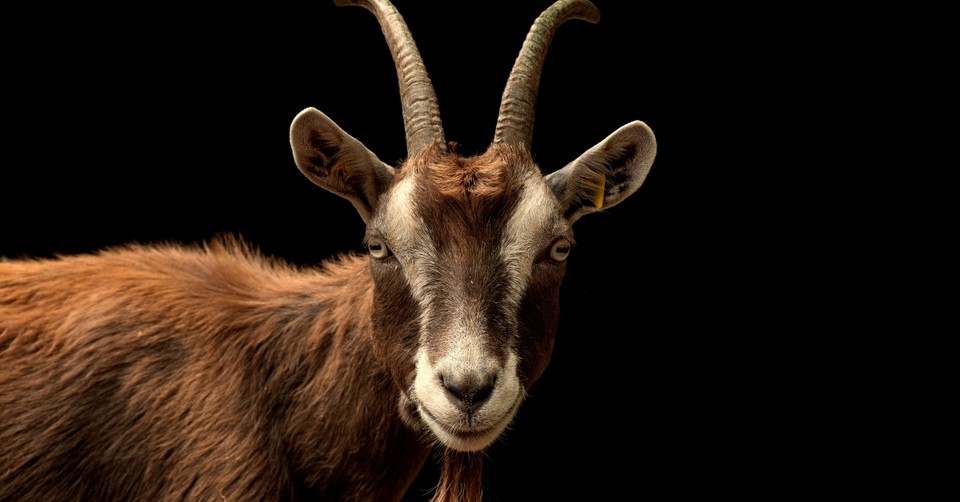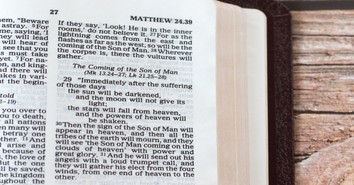Why Is Satan Depicted as a Goat?

When my daughter was little, she wanted goats. So, for Christmas that year, my husband and I went from one end of North Carolina to the other and bought her two miniature Nubian goats. She was so excited to watch them grow up and milk them when they had babies. Those two little girl goats grew, and we had two little babies. Everyone thought they were so cute, and we just loved carrying them around.
However, our relationship with the goats was a love/hate one. The older goats would graze around the farm and come into their pen at night without our intervention. But those younger ones were a handful. The male would jump on the cars and poop on the porch. You could put them in the pen and watch them jump over the gate in five minutes.
My experience with goats has made me wonder why goats have become the mascot for Satan. When did goats become the reference for Satan? Further, why did Christ refer to his children as sheep and goats?
Characteristics of Goats
For a well-rounded conversation regarding goats and Satan, lets start with characteristics of a goat. Goats are sly little animals. They like to frolic and play. They like to forage and eat your rose bushes. They are even cuddly and cute. For all their good characteristics, there are some that get on your last nerve.
Goats are stubborn. They like to do their own thing with no shepherd or farmer guiding them. All the goats my family had wore collars with bells on them, so we knew where they were. They liked being free to do their own thing. Herding them was close to impossible.
So are these characteristics similar to Satan? Can’t he be sly, cuddly, and cute when he is telling us to do our own thing instead of relying on the Good Shepherd to guide us?
When Did Goats Become a Reference to Satan?
The imagery of Satan as a goat is built upon the ancient world and paganism. The Greek gods were often given elements of animal characteristics. One such god was Pan. Pan was the god who ruled over pastures, wooded land, and nature. He is depicted as an energetic, frightening, and unbridled force of nature. The Greek name Pan is actually where we get the English word panic.
Satan has been referred to as many things, but a goat became a new identity in the 6th century. A mosaic was discovered in Italy that depicted Satan as a goat. In this same mosaic, an angel sat beside Jesus, who was choosing a sheep. The mosaic was a depiction of the parable we find in Matthew 25:31-46, which describes what will happen upon Christ’s return and the final judgement.
Another early depiction of Satan as a goat is in the pagan idol Baphomet. Baphomet is depicted as a winged, human figure with the head and feet of a goat. The first mention of Baphomet is found in a letter written in 1098 by Anselm of Ribemont regarding the Siege of Antioch during the First Crusade.
In 1861, author Eliphas Levi, a French magician and occultist, created an illustration depicting a winged man with a goat’s head. He wanted to use this illustration in his book, Transcendental Magic: Its Doctrine and Ritual. His image began to be called the Sabbatic Goat.
The 1960s saw the beginnings of what is deemed the Church of Satan. It was formed by a carnival worker named Howard Stanton Levy. He used the depiction of goat’s head inside a pentagram as the church’s insignia.
Early historical records show that goats were often used to depict wild or evil forces. Pagan religions used this imagery frequently. From the beginning of time, Satan has been and continues to become many things.
Did Christ Refer to Satan as a Goat?
Christ did not describe Satan as a goat anywhere in Scripture, but He did use goats as way for the Israelites to atone for their sins and show the people of Jesus’ day what it meant to be a child of God. The first significant mention of goats is in Leviticus 16:7-10.
“Next, he will take the two goats and place them before the Lord at the entrance to the tent of meeting. After Aaron casts lots for the two goats, one lot for the Lord and the other for an uninhabitable place, he is to present the goat chosen by lot for the Lord and sacrifice it as a sin offering. But the goat chosen by lot for an uninhabitable place is to be presented alive before the Lord to make atonement with it by sending it into the wilderness for an uninhabitable place.”
The Scripture from Leviticus is just one of the instructions given by God to Moses for the Day of Atonement. God’s words in Leviticus gives goats a sacred quality, yet they were the animal chosen to atone all the sins of Israel, just as Satan holds the sins of the world.
Goats were often used in pagan worship and God specifically speaks against this in Leviticus 17:7.
“They must no longer offer their sacrifices to the goat-demons that they have prostituted themselves with. This will be a permanent statute for them throughout their generations.”
Probably the most notable mention of goats in the Bible can be found in Matthew 25:31-46. In this passage Christ uses a parable of sheep and goats to paint the picture of what will happen when the Son of Man returns. Jesus says that all the nations will be there and be separated from one another just as the shepherd separates the sheep from the goats. The sheep will be on the right and the goats on the left of the glorious throne. At the end of the parable, Jesus will tell those on the left to depart from Him because they are cursed and will dwell in the eternal fire.
Being on the right of Christ is significant because it is the right side which is used to share God’s promises and righteousness to His children. These promises include protection (Psalm 44:3), strength (Exodus 15:6), and provision (Isaiah 41:10) just to name a few. The summation of all the Scripture tells us that Satan does not and will not ever be on the right side of Christ. Therefore, in Matthew 25:31-46, Jesus is comparing a goat who is on His left with Satan and eternal damnation.
What Is the Answer?
When Jesus walked this earth, He lived in an agrarian society. Goats were used to provide milk and meat to families. They were also used to make appropriate sacrifices for the sins of the people. From the beginning, goats faced the consequences of sin just as Satan faced the consequences of sin when he was cast out of heaven (Ezekiel 28).
Mythology, paganism, and the modern-day Church of Satan have latched on to the idea that a goat is an appropriate symbol for Satan. Scripture uses a goat to express what side of Christ we will be on if we reject his Him.
So, I pose the question again. Why is Satan described as goat? Well, the answer is not clear. It is a conglomeration of many ideas, folklore, mythology, and pagan societies. The ancient world had a different view of religion, and those views become mixed in with the Christian world. Scripture and human minds have come together to create this image of a goat and all its evil ways.
Photo credit: Unsplash/Peter Neumann

Originally published February 04, 2025.





